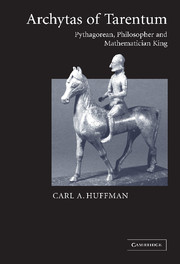Book contents
- Frontmatter
- Contents
- List of figures
- Preface
- PART ONE INTRODUCTORY ESSAYS
- PART TWO GENUINE FRAGMENTS
- PART THREE GENUINE TESTIMONIA
- I Testimonia for Archytas' life, writings and reception
- II Moral philosophy and character
- III Geometry: The duplication of the cube
- IV Music
- V Metaphysics
- VI Physics
- VII Miscellaneous testimonia
- Appendix 1 Spurious writings and testimonia
- Appendix 2 Archytas' name
- Bibliography
- Select index of Greek words and phrases
- Index locorum
- General index
III - Geometry: The duplication of the cube
Published online by Cambridge University Press: 04 August 2010
- Frontmatter
- Contents
- List of figures
- Preface
- PART ONE INTRODUCTORY ESSAYS
- PART TWO GENUINE FRAGMENTS
- PART THREE GENUINE TESTIMONIA
- I Testimonia for Archytas' life, writings and reception
- II Moral philosophy and character
- III Geometry: The duplication of the cube
- IV Music
- V Metaphysics
- VI Physics
- VII Miscellaneous testimonia
- Appendix 1 Spurious writings and testimonia
- Appendix 2 Archytas' name
- Bibliography
- Select index of Greek words and phrases
- Index locorum
- General index
Summary
A14 Eutocius, Commentary on Archimedes' On the Sphere and Cylinder II (III. 84.12–88.2 Heiberg/Stamatis)
(See also the Verba Filiorum of the Banu Musa, Clagett 1964: 334–41)
The Solution of Archytas, as Eudemus reports it.
Let the two given straight lines be AΔ and Γ. It is then necessary to find two mean proportionals of AΔ and Γ. Let the circle ABΔZ be drawn around the greater AΔ, let AB, equal to Γ a, be fit into (the circle) and being extended let it meet the line, which is tangent to the circle and drawn from Δ, at Π. Let line BEZ be drawn parallel to Π ΔO, and let a right semicylinder be conceived on the semicircle ABΔ, and on AΔ a semicircle at right angles lying in the rectangle of the semicylinder. When this semicircle is rotated from Δ to B, while the endpoint A of the diameter remains fixed, it will cut the cylindrical surface in its rotation and will describe a line on it. And again, if, while AΔ remains fixed, the triangle AΠΔ is rotated in an opposite motion to that of the semicircle, it will make the surface of a cone with the line AΔ, which as it is rotated will meet the line on the cylinder in a point. At the same time the point B will also describe a semicircle on the surface of the cone. Let the moving semicircle have as its position ΔKA at the place where the lines meet, and let the triangle being rotated in the opposite direction have as its place Δo?ΛA, and let the point of intersection described above be K.
- Type
- Chapter
- Information
- Archytas of TarentumPythagorean, Philosopher and Mathematician King, pp. 342 - 401Publisher: Cambridge University PressPrint publication year: 2005

